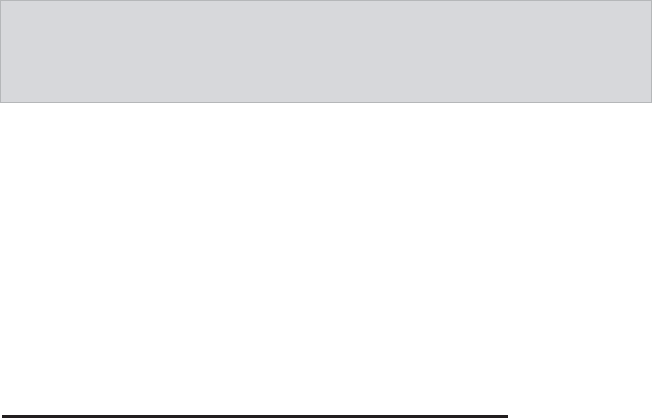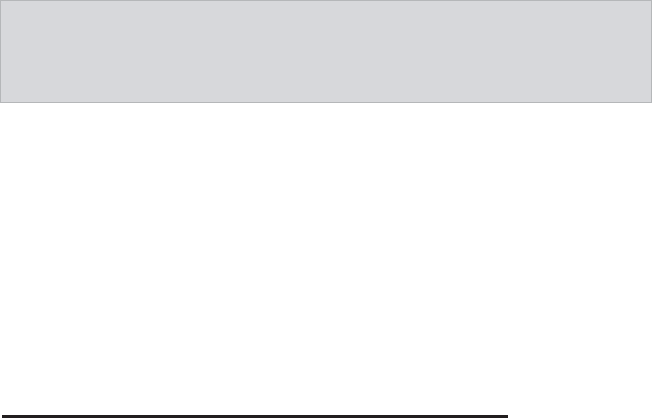Fabozzi Frank, Peterson Pamela. Financial Management and Analysis Workbook
Подождите немного. Документ загружается.


300 SOLUTIONS
9. good; need, pay, lend, compensated; interest rate; greater, higher,
lower, lower
10. secondary, price; interest, price; face, yield, coupon
11. creditworthiness, Moody’s, Standard & Poor’s, Fitch; high grade;
triple A; investment, noninvestment, high, junk
12. embedded, bondholder, issuer; call; retire; put; sell; convertible
13. yield, expectations, pure, liquidity, preferred habitat; segmentation
SHORT ANSWER QUESTIONS
Answers
1. Financial intermediaries can raise capital by issuing financial claims
against themselves that investors purchase. The company uses the
money raised to invest and technically, the investors are investing by
indirect means through the financial intermediary. The investments
offered provide the investor with a range of diversified investments that
have various maturity dates at reduced costs.
2. There are several types of deposit institutions: commercial banks,
savings and loan associations or thrifts, mutual savings banks, and
credit unions.
■
Commercial banks: corporations owned by investors that lend to
businesses and offer a multitude of basic financial services
■
Savings and loan associations: institutions owned by depositors that
concentrate on offering home mortgage loans
■
Mutual savings banks: institutions owned by depositors that provide
loans to the local community
■
Credit unions: nonprofit associations owned by depositors that
make personal loans to members
3. There are a number of nondeposit financial institutions that hold
financial assets:
■
Trust companies: act as trustee based on the terms of a contract
SolCh3 Page 300 Tuesday, December 16, 2003 9:23 AM

Financial Institutions and the Cost of Money 301
■
Investment companies: invest in pools of assets with finances raised
from the sale of stock
■
Pension funds: Manage workers’ retirement accumulation in stocks
and bonds
■
Insurers: provide a range of protection polices for the investor
4. There are many interest rates in any economy, called a structure of
interest rates, and they are determined by many factors. Traditionally
Treasury securities’ interest rates serve as the benchmark of interest
rates. The risk premium is the interest rate on a non-Treasury security
and it factors in any other risks an investor may bear by buying it.
These other risks include creditworthiness, option provisions,
demand in the market (liquidity), the length to maturity, and tax con-
sequences.
5. The theoretical interest rates or yields that the U.S. Treasury would
pay for bonds with differing maturities are Treasury spot rates. Spot
rates are also known as forward rates and some believe them to be
the market’s consensus of future interest rates. In this market consen-
sus, the market prices expectations of future interest rates into the
existing interest rates of investments with differing maturities. Under-
standing forward rates is helpful for hedging because it facilitates the
use of options in order to avoid an unfavorable future interest rate.
6. The term structure of interest rates relates the yield on a bond to its
maturity; the yield curve is the graph of this relationship that extends
it over different maturities. The graph of the term structure can have
the following shapes: a normal or upward-sloping curve, indicating
the yield rises steadily as maturity increases; a downward-sloping or
inverted yield curve, where yields decline as maturity increases; and a
flat yield curve.
SolCh3 Page 301 Tuesday, December 16, 2003 9:23 AM
SolCh3 Page 302 Tuesday, December 16, 2003 9:23 AM

CHAPTER
4
303
Introduction to Derivatives
FILL IN THE BLANKS
Answers
1. futures, buy, sell, underlying; futures; settlement
2. economic, hedge, risk; Futures, exchanges, agricultural, industrial;
stock, interest, currency
3. Clearinghouse, guaranteeing; Counterparty, settlement; futures
4. deposit, minimum; initial; price, fluctuates, position; market, mark-
ing, market, marking, market
5. buying, long; sale, short; buyer, profit, increases, seller, profit,
decreases
6. writer, buyer, sell, price, period; premium; exercised; expiration
7. any, expiration, American; expiration, European; before, specified,
Bermuda
8. intrinsic; time; economic, exercised
9. swap, periodic; dollar, notional principal; Swaps, nonfinance, inter-
est, currency, commodity; risk, return, forward
SolCh4 Page 303 Tuesday, December 16, 2003 9:24 AM

304 SOLUTIONS
10. cap, seller, buyer, exceeds; floor, seller, buyer, less; interest, commod-
ity; cap, call, floor, put
SHORT ANSWER QUESTIONS
Answers
1. There are a variety of derivative instruments including futures con-
tracts, forward contracts, option contracts, swap agreements, and cap
and floor agreements. Derivative instruments are investment products
that help firms to hedge against certain risks that are uninsurable. The
value of the derivative comes from the basis of the contract.
2. A futures contract offers liquidation opportunities prior to the settle-
ment date. This is achieved by the holder taking what is called an off-
setting position in the same contract. The holder may also liquidate a
futures contract on the settlement date. The purchaser of a futures
contract receives the underlying item at the agreed-upon price. The
seller liquidates the position by delivering the underlying at the
agreed-upon price.
3. Forward contracts are nonstandardized, therefore terms for each con-
tract are decided between the buyer and seller. Clearinghouses and
secondary markets do not exist for forwards, therefore they are traded
over-the-counter. Both futures and forward contracts provide delivery
terms, however, futures contracts are not supposed to be settled by
delivery as are forward contracts. Futures contracts are marked-to-
market at the end of each trading day, meaning that the accounts are
adjusted according to the daily closing prices. Further, this means
futures accounts are allowed to have varying cash flows in and out
according to price fluctuation. A forward does not have to be marked-
to-market, this implies account cash flows do not vary. Finally, unlike
investors in futures, investors in a forwards face credit risk exposure,
or counterparty risk, since a party may default on the obligation espe-
cially since there is no clearinghouse or secondary market.
4. With an option, the buyer has the right but not the obligation to trans-
act and the option writer must perform. In the case of a futures con-
tract, both buyer and seller are obligated to perform. However, a
futures buyer does not pay the seller to accept the obligation, while an
SolCh4 Page 304 Tuesday, December 16, 2003 9:24 AM

Introduction to Derivatives 305
option buyer pays the seller an option price. The risks and rewards for
the two contracts differ accordingly: Buyers of futures contracts real-
ize a dollar-for-dollar gain (loss) when the price of the futures contract
increases (decreases), and vice versa for sellers of futures contracts.
Options do not have this. The most that the buyer of an option can
lose is the option price at the same time they maintain all the benefits.
The writer’s profit is the option price, however the writer assumes
much downside risk. Savvy investors use futures to protect against
symmetric risk and options to protect against asymmetric risk.
5. Swaps are multiple packages of forward contracts. Because forward
contracts do not have a long maturity, investors who need a longer
maturity can find it in a swap. Also, swaps are convenient as the pay-
off for the bundle of forward contracts is negotiated together and not
separately. Further, swaps have become quite liquid and there is more
of a demand for them in the market.
PROBLEMS
Answers
1. The futures price of Asset X increases to $135. Alex, the buyer of the
futures contract, could then sell the futures contract and realize a profit
of $35 ($135 minus the futures price of $100). Effectively, at the settle-
ment date he has agreed to buy Asset X for $100 but can sell Asset X
for $135. Adrienne, the seller of the futures contract, will realize a loss
of $35. If the futures price falls to $50 and Adrienne buys the contract,
she realizes a profit of $50 because she agreed to sell Asset X for $100
and now can buy it for $50. Alex would realize a loss of $50. Thus, if
the futures price decreases, the buyer of the futures contract realizes a
loss while the seller of a futures contract realizes a profit.
2. Because it is an American call option, it may be exercised at any time
up to and including the expiration date. Lydia can decide to buy from
the writer of this option one unit of Asset X, for which she will pay a
price of $75. If it is not beneficial for her to exercise the option, she
will not. Whether the option is exercised or not, the $3 paid for the
option will be kept by the option writer. If Lydia buys a put option,
then she would be able to sell Asset X to the option writer for a price
of $75. The maximum amount Lydia can lose is the option price. The
SolCh4 Page 305 Tuesday, December 16, 2003 9:24 AM

306 SOLUTIONS
maximum profit that the option writer can realize is the option price.
Lydia has substantial upside return potential, while the option writer
has substantial downside risk. There are no margin requirements for
Lydia once the option price has been paid in full. Because the option
price is the maximum amount Lydia can lose, no matter how adverse
the price movement of the underlying, there is no need for margin.
Because the writer of an option has agreed to accept all of the risk
and none of the reward of the position in the underlying, the writer is
generally required to put up the option price received as margin. In
addition, as price changes occur that adversely affect the writer’s
position, the writer is required to deposit additional margin because
the position is marked to market.
3. The profit and loss from the strategy will depend on the price of Asset
X at the expiration date. A number of outcomes are possible.
■
If the price of Asset X at the expiration date is less than $40 (the
option price), then the investor will not exercise the option. It would
be foolish to pay the option writer $60 when Asset X can be pur-
chased in the market at a lower price. In this case, the option buyer
loses the entire option price of $2. Notice, however, that this is the
maximum loss that the option buyer will realize, regardless of how
low Asset X’s price declines.
■
If Asset X’s price is equal to $40 at the expiration date, there is again
no economic value in exercising the option. As in the case where the
price is less than $40, the buyer of the call option will lose the entire
option price, $2.
■
If Asset X’s price is more than $40 but less than $42 at the expira-
tion date, the option buyer will exercise the option. By exercising,
the option buyer can purchase Asset X for $40 (the exercise price)
and sell it in the market for the higher price. Suppose, for example,
that Asset X’s price is $41 at the expiration date. The buyer of the
call option will realize a $1 gain by exercising the option. Of course,
the cost of purchasing the call option was $2, so $1 is lost on this
position. By failing to exercise the option, the investor loses $2
instead of only $1.
■
If Asset X’s price at the expiration date is equal to $42, the investor
will exercise the option. In this case, the investor breaks even, realiz-
ing a gain of $2 that offsets the cost of the option, $2.
■
If Asset X’s price at the expiration date is more than $42, the inves-
tor will exercise the option and realize a profit. For example, if the
price is $50, exercising the option will generate a profit on Asset X
SolCh4 Page 306 Tuesday, December 16, 2003 9:24 AM

Introduction to Derivatives 307
of $10. Reducing this gain by the cost of the option ($2), the inves-
tor will realize a net profit from this position of $8.
4. The intrinsic value is $110 – 100 = $10. That is, an option buyer
exercising the option and simultaneously selling the underlying asset
would realize $110 from the sale of the underlying, which would be
covered by acquiring the underlying from the option writer for $100,
thereby netting a $10 gain. This option is “in the money.” When the
exercise price of a call option exceeds the current price of the underly-
ing, the call option is out-of-the money and has no intrinsic value. If
the exercise price is equal to the current price it is at-the-money and
also has no intrinsic value (0).
For a put option, the intrinsic value is equal to the amount by
which the current price of the underlying is below the exercise price:
$100 – 90 = $10. The buyer of the put option who exercises the put
option and simultaneously sells the underlying will net $10 by exer-
cising. The asset will be sold to the writer for $100 and purchased in
the market for $90. For the put option, it would be: in-the-money
when the price of the underlying is less than exercise price, out-of-the
money when the current price exceeds the exercise price, and at-the-
money when the exercise price is equal to the current price.
5. Consider a corn farmer and a canning company that uses the corn in
the operation of its business. The concern of the farmer is that the
price of corn will decline, thereby forcing him (or her) to sell his corn
at a lower price. The concern of the canning company is that the price
of corn will increase, resulting in a rise in its production costs. Con-
sider first the farmer; suppose the corn will be available at a time
when the farmer can sell a corn futures contract to deliver corn for
$X per bushel. The number of bushels expected to be sold will deter-
mine how many bushels of corn the farmer will seek to deliver. By
selling futures, the farmer has locked in a price of $X per bushel.
Consequently, even if the price of corn is $X – 2 per bushel, the
farmer will receive $X per bushel. If instead, the price of corn is $X +
2 per bushel, the farmer has given up the opportunity to benefit from
a higher price because he has agreed to accept $X per bushel.
Now let’s look at the canner. By buying a corn futures contract,
the canner can assure that the price at which it must purchase corn
will be no higher than $X per bushel. So, if corn increases to $X + 2
per bushel, the canner only needs to pay $X per bushel. In contrast, if
the price of corn decreases to $X – 2 per bushel, the canner gave up
the opportunity to benefit from a lower cost for corn.
SolCh4 Page 307 Tuesday, December 16, 2003 9:24 AM
SolCh4 Page 308 Tuesday, December 16, 2003 9:24 AM

CHAPTER
5
309
Taxation
FILL IN THE BLANKS
Answers
1. Congress, legislation, Internal Revenue Code; Internal Revenue Ser-
vice (IRS), interprets, adds, implements; IRS, providing, processing,
collecting, explaining, rulings
2. income tax, 1909, simple, complex; analyst, today, future; after, per-
formance, changing
3. marginal, defines, bracket, dollar; average, ratio, paid; progressive,
average, higher; investment, financing, taxable, marginal
4. shareholders, dividends, twice, corporate, shareholders’, corporation,
third; triple, dividends-received; recipient, dividends, dividend, tax-
able; dividends-received, increases, return, investing
5. accelerated, straight-line; depreciation, rate, physical, effect, income;
uniformity, depreciation, taxpayers, calculations, accelerated, shorter
6. capital gain, realized, sold, paid; treatment, lower, tax
7. Investment, ITC, stimulate, reducing, computed; ITC, reinstated,
Congress, spending; credits, deductions, reduce, deduction, indirectly
8. net operating loss, deductions, income; back, preceding, forward,
future, reduce; back, forward
SolCh5 Page 309 Tuesday, December 16, 2003 9:24 AM
